Phenoxazine-Dibenzothiophene Sulfoximine Emitters Featuring Both Thermally Activated Delayed Fluorescence and Aggregation Induced Emission
Abstract
:1. Introduction
2. Experimental Section
2.1. Materials
2.2. General Information
2.3. Synthesis
2.3.1. PXZ-SFIP
2.3.2. PXZ-SFIC
2.3.3. PXZ-SFIS
2.4. Fabrication and Characterization of Devices
3. Results and Discussions
3.1. Synthesis and Characterization
3.2. Thermal and Electrochemical Properties
3.3. Theoretical Calculation
3.4. Photophysical Properties
3.5. Device Characterization
4. Conclusions
Supplementary Materials
Author Contributions
Funding
Institutional Review Board Statement
Informed Consent Statement
Data Availability Statement
Acknowledgments
Conflicts of Interest
Sample Availability
References
- Endo, A.; Sato, K.; Yoshimura, K.; Kai, T.; Kawada, A.; Miyazaki, H.; Adachi, C. Efficient up-conversion of triplet excitons into a singlet state and its application for organic light emitting diodes. Appl. Phys. Lett. 2011, 98, 083302. [Google Scholar] [CrossRef]
- dos Santos, P.L.; Etherington, M.K.; Monkman, A.P. Chemical and conformational control of the energy gaps involved in the thermally activated delayed fluorescence mechanism. J. Mater. Chem. C 2018, 6, 4842–4853. [Google Scholar] [CrossRef]
- Zhang, Q.; Li, B.; Huang, S.; Nomura, H.; Tanaka, H.; Adachi, C. Efficient blue organic light-emitting diodes employing thermally activated delayed fluorescence. Nat. Photonics 2014, 8, 326–332. [Google Scholar] [CrossRef]
- Zou, Y.; Gong, S.; Xie, G.; Yang, C. Design Strategy for Solution-Processable Thermally Activated Delayed Fluorescence Emitters and Their Applications in Organic Light-Emitting Diodes. Adv. Opt. Mater. 2018, 6, 1800568. [Google Scholar] [CrossRef]
- Zhang, D.; Song, X.; Cai, M.; Duan, L. Blocking Energy-Loss Pathways for Ideal Fluorescent Organic Light-Emitting Diodes with Thermally Activated Delayed Fluorescent Sensitizers. Adv. Mater. 2018, 30, 1705250. [Google Scholar] [CrossRef]
- Tao, Y.; Yuan, K.; Chen, T.; Xu, P.; Li, H.; Chen, R.; Zheng, C.; Zhang, L.; Huang, W. Thermally Activated Delayed Fluorescence Materials Towards the Breakthrough of Organoelectronics. Adv. Mater. 2014, 26, 7931–7958. [Google Scholar] [CrossRef] [PubMed]
- Uoyama, H.; Goushi, K.; Shizu, K.; Nomura, H.; Adachi, C. Highly efficient organic light-emitting diodes from delayed fluorescence. Nature 2012, 492, 234–238. [Google Scholar] [CrossRef] [PubMed]
- Goushi, K.; Yoshida, K.; Sato, K.; Adachi, C. Organic light-emitting diodes employing efficient reverse intersystem crossing for triplet-to-singlet state conversion. Nat. Photonics 2012, 6, 253–258. [Google Scholar] [CrossRef]
- Hirata, S.; Sakai, Y.; Masui, K.; Tanaka, H.; Lee, S.Y.; Nomura, H.; Nakamura, N.; Yasumatsu, M.; Nakanotani, H.; Zhang, Q. Highly efficient blue electroluminescence based on thermally activated delayed fluorescence. Nat. Mater. 2015, 14, 330–336. [Google Scholar] [CrossRef] [PubMed]
- Liu, Y.; Li, C.; Ren, Z.; Yan, S.; Bryce, M.R. All-organic thermally activated delayed fluorescence materials for organic light-emitting diodes. Nat. Rev. Mater. 2018, 3, 18020. [Google Scholar] [CrossRef]
- He, J.; He, Y.; Chen, Y.; Zhang, X.; Hu, C.; Zhuang, J.; Lei, B.; Liu, Y. Construction and multifunctional applications of carbon dots/PVA nanofibers with phosphorescence and thermally activated delayed fluorescence. Chem. Eng. J. 2018, 347, 505–513. [Google Scholar] [CrossRef]
- Shizu, K.; Noda, H.; Tanaka, H.; Taneda, M.; Uejima, M.; Sato, T.; Tanaka, K.; Kaji, H.; Adachi, C. Highly efficient blue electroluminescence using delayed-fluorescence emitters with large overlap density between luminescent and ground states. J. Phys. Chem. C 2015, 119, 26283–26289. [Google Scholar] [CrossRef]
- Yu, L.; Wu, Z.; Xie, G.; Zhong, C.; Zhu, Z.; Cong, H.; Ma, D.; Yang, C. Achieving a balance between small singlet–triplet energy splitting and high fluorescence radiative rate in a quinoxaline-based orange-red thermally activated delayed fluorescence emitter. Chem. Commun. 2016, 52, 11012–11015. [Google Scholar] [CrossRef]
- Yang, Z.; Mao, Z.; Xie, Z.; Zhang, Y.; Liu, S.; Zhao, J.; Xu, J.; Chi, Z.; Aldred, M.P. Recent advances in organic thermally activated delayed fluorescence materials. Chem. Soc. Rev. 2017, 46, 915–1016. [Google Scholar] [CrossRef]
- Dias, F.B.; Penfold, T.J.; Monkman, A.P. Photophysics of thermally activated delayed fluorescence molecules. Methods Appl. Fluoresc. 2017, 5, 012001. [Google Scholar] [CrossRef] [PubMed]
- Im, Y.; Kim, M.; Cho, Y.J.; Seo, J.-A.; Yook, K.S.; Lee, J.Y. Molecular Design Strategy of Organic Thermally Activated Delayed Fluorescence Emitters. Chem. Mater. 2017, 29, 1946–1963. [Google Scholar] [CrossRef]
- Bronstein, H.; Nielsen, C.B.; Schroeder, B.C.; McCulloch, I. The role of chemical design in the performance of organic semiconductors. Nat. Rev. Chem. 2020, 4, 66–77. [Google Scholar] [CrossRef]
- Higginbotham, H.F.; Yi, C.-L.; Monkman, A.P.; Wong, K.-T. Effects of Ortho-Phenyl Substitution on the rISC Rate of D–A Type TADF Molecules. J. Phys. Chem. C 2018, 122, 7627–7634. [Google Scholar] [CrossRef] [Green Version]
- Godumala, M.; Yoon, J.; Park, S.Y.; Lee, C.; Kim, Y.; Jeong, J.-E.; Park, S.; Woo, H.Y.; Cho, M.J.; Choi, D.H. 5H-Benzo[d]Benzo[4,5]Imidazo[2,1-b][1,3]Thiazine as a Novel Electron-Acceptor Cored High Triplet Energy Bipolar Host Material for Efficient Solution-Processable Thermally Activated Delayed Fluorescence Organic Light-Emitting Diodes. Front. Chem. 2020, 8. [Google Scholar] [CrossRef] [PubMed] [Green Version]
- Cai, X.; Su, S.-J. Marching Toward Highly Efficient, Pure-Blue, and Stable Thermally Activated Delayed Fluorescent Organic Light-Emitting Diodes. Adv. Funct. Mater. 2018, 28, 1802558. [Google Scholar] [CrossRef]
- Wu, K.; Zhang, T.; Wang, Z.; Wang, L.; Zhan, L.; Gong, S.; Zhong, C.; Lu, Z.-H.; Zhang, S.; Yang, C. De Novo Design of Excited-State Intramolecular Proton Transfer Emitters via a Thermally Activated Delayed Fluorescence Channel. J. Am. Chem. Soc. 2018, 140, 8877–8886. [Google Scholar] [CrossRef] [PubMed]
- Xiang, Y.; Zhao, Y.; Xu, N.; Gong, S.; Ni, F.; Wu, K.; Luo, J.; Xie, G.; Lu, Z.-H.; Yang, C. Halogen-induced internal heavy-atom effect shortening the emissive lifetime and improving the fluorescence efficiency of thermally activated delayed fluorescence emitters. J. Mater. Chem. C 2017, 5, 12204–12210. [Google Scholar] [CrossRef]
- Chen, J.X.; Tao, W.W.; Chen, W.C.; Xiao, Y.F.; Wang, K.; Cao, C.; Yu, J.; Li, S.; Geng, F.X.; Adachi, C. Red/Near-Infrared Thermally Activated Delayed Fluorescence OLEDs with Near 100% Internal Quantum Efficiency. Angew. Chem. Int. Ed. 2019, 58, 14660–14665. [Google Scholar] [CrossRef] [PubMed]
- Zhang, Y.L.; Ran, Q.; Wang, Q.; Liu, Y.; Hänisch, C.; Reineke, S.; Fan, J.; Liao, L.S. High-Efficiency Red Organic Light-Emitting Diodes with External Quantum Efficiency Close to 30% Based on a Novel Thermally Activated Delayed Fluorescence Emitter. Adv. Mater. 2019, 31, 1902368. [Google Scholar] [CrossRef] [PubMed]
- Pathak, S.K.; Xiang, Y.; Huang, M.; Huang, T.; Cao, X.; Liu, H.; Xie, G.; Yang, C. Fused tetracyclic tris[1,2,4]triazolo[1,3,5]triazine as a novel rigid electron acceptor for efficient thermally activated delayed fluorescence emitters. RSC Adv. 2020, 10, 15523–15529. [Google Scholar] [CrossRef] [Green Version]
- Cao, X.; Zhang, D.; Zhang, S.; Tao, Y.; Huang, W. CN-Containing donor–acceptor-type small-molecule materials for thermally activated delayed fluorescence OLEDs. J. Mater. Chem. C 2017, 5, 7699–7714. [Google Scholar] [CrossRef]
- Kim, J.H.; Yun, J.H.; Lee, J.Y. Recent Progress of Highly Efficient Red and Near-Infrared Thermally Activated Delayed Fluorescent Emitters. Adv. Opt. Mater. 2018, 6, 1800255. [Google Scholar] [CrossRef]
- Xiao, R.; Xiang, Y.; Cao, X.; Li, N.; Huang, T.; Zhou, C.; Zou, Y.; Xie, G.; Yang, C. Star-shaped thermally activated delayed fluorescence emitters with a tri-armed arylsulfonic acceptor for efficient solution processed organic light emitting diodes. J. Mater. Chem. C 2020, 8, 5580–5586. [Google Scholar] [CrossRef]
- Wang, Y.; Zhang, Y.; Hu, W.; Quan, Y.; Li, Y.; Cheng, Y. Circularly Polarized Electroluminescence of Thermally Activated Delayed Fluorescence-Active Chiral Binaphthyl-Based Luminogens. ACS Appl. Mater. Interfaces 2019, 11, 26165–26173. [Google Scholar] [CrossRef] [PubMed]
- Matsuoka, K.; Albrecht, K.; Nakayama, A.; Yamamoto, K.; Fujita, K. Highly Efficient Thermally Activated Delayed Fluorescence Organic Light-Emitting Diodes with Fully Solution-Processed Organic Multilayered Architecture: Impact of Terminal Substitution on Carbazole–Benzophenone Dendrimer and Interfacial Engineering. ACS Appl. Mater. Interfaces 2018, 10, 33343–33352. [Google Scholar] [CrossRef]
- Xu, J.; Zhu, X.; Guo, J.; Fan, J.; Zeng, J.; Chen, S.; Zhao, Z.; Tang, B.Z. Aggregation-Induced Delayed Fluorescence Luminogens with Accelerated Reverse Intersystem Crossing for High-Performance OLEDs. ACS Mater. Lett. 2019, 1, 613–619. [Google Scholar] [CrossRef]
- Im, Y.; Han, S.H.; Lee, J.Y. Deep blue thermally activated delayed fluorescent emitters using CN-modified indolocarbazole as an acceptor and carbazole-derived donors. J. Mater. Chem. C 2018, 6, 5012–5017. [Google Scholar] [CrossRef]
- Wong, M.Y.; Krotkus, S.; Copley, G.; Li, W.; Murawski, C.; Hall, D.; Hedley, G.J.; Jaricot, M.; Cordes, D.B.; Slawin, A.M.Z.; et al. Deep-Blue Oxadiazole-Containing Thermally Activated Delayed Fluorescence Emitters for Organic Light-Emitting Diodes. ACS Appl. Mater. Interfaces 2018, 10, 33360–33372. [Google Scholar] [CrossRef] [PubMed] [Green Version]
- Chan, C.Y.; Cui, L.S.; Kim, J.U.; Nakanotani, H.; Adachi, C. Rational Molecular Design for Deep-Blue Thermally Activated Delayed Fluorescence Emitters. Adv. Funct. Mater. 2018, 28, 1706023. [Google Scholar] [CrossRef]
- Lin, C.-C.; Huang, M.-J.; Chiu, M.-J.; Huang, M.-P.; Chang, C.-C.; Liao, C.-Y.; Chiang, K.-M.; Shiau, Y.-J.; Chou, T.-Y.; Chu, L.-K.; et al. Molecular Design of Highly Efficient Thermally Activated Delayed Fluorescence Hosts for Blue Phosphorescent and Fluorescent Organic Light-Emitting Diodes. Chem. Mater. 2017, 29, 1527–1537. [Google Scholar] [CrossRef]
- Gibson, J.; Monkman, A.P.; Penfold, T.J. The Importance of Vibronic Coupling for Efficient Reverse Intersystem Crossing in Thermally Activated Delayed Fluorescence Molecules. ChemPhysChem 2016, 17, 2956–2961. [Google Scholar] [CrossRef] [Green Version]
- Xie, G.; Luo, J.; Huang, M.; Chen, T.; Wu, K.; Gong, S.; Yang, C. Inheriting the Characteristics of TADF Small Molecule by Side-Chain Engineering Strategy to Enable Bluish-Green Polymers with High PLQYs up to 74% and External Quantum Efficiency over 16% in Light-Emitting Diodes. Adv. Mater. 2017, 29, 1604223. [Google Scholar] [CrossRef] [PubMed]
- Neena, K.K.; Sudhakar, P.; Thilagar, P. Catalyst- and Template-Free Ultrafast Visible-Light-Triggered Dimerization of Vinylpyridine-Functionalized Tetraarylaminoborane: Intriguing Deep-Blue Delayed Fluorescence. Angew. Chem. Int. Ed. 2018, 57, 16806–16810. [Google Scholar] [CrossRef] [PubMed]
- Bunzmann, N.; Weissenseel, S.; Kudriashova, L.; Gruene, J.; Krugmann, B.; Grazulevicius, J.V.; Sperlich, A.; Dyakonov, V. Optically and electrically excited intermediate electronic states in donor:acceptor based OLEDs. Mater. Horiz. 2020, 7, 1126–1137. [Google Scholar] [CrossRef] [Green Version]
- Zeng, W.; Lai, H.Y.; Lee, W.K.; Jiao, M.; Shiu, Y.J.; Zhong, C.; Gong, S.; Zhou, T.; Xie, G.; Sarma, M.; et al. Achieving Nearly 30% External Quantum Efficiency for Orange-Red Organic Light Emitting Diodes by Employing Thermally Activated Delayed Fluorescence Emitters Composed of 1,8-Naphthalimide-Acridine Hybrids. Adv. Mater. 2018, 30, 1704961. [Google Scholar] [CrossRef]
- Lücking, U. Sulfoximines: A Neglected Opportunity in Medicinal Chemistry. Angew. Chem. Int. Ed. 2013, 52, 9399–9408. [Google Scholar] [CrossRef] [PubMed]
- Wiezorek, S.; Lamers, P.; Bolm, C. Conversion and degradation pathways of sulfoximines. Chem. Soc. Rev. 2019, 48, 5408–5423. [Google Scholar] [CrossRef] [PubMed]
- Bizet, V.; Hendriks, C.M.; Bolm, C. Sulfur imidations: Access to sulfimides and sulfoximines. Chem. Soc. Rev. 2015, 44, 3378–3390. [Google Scholar] [CrossRef] [PubMed] [Green Version]
- Cao, X.; Chen, Z.; Gong, S.; Pan, K.; Zhou, C.; Huang, T.; Chai, D.; Zhan, Q.; Li, N.; Zou, Y.; et al. Designing Versatile Sulfoximine as Accepting Unit to Regulate the Photophysical Properties of TADF Emitters towards High-performance OLEDs. Chem. Eng. J. 2020, 399, 125648. [Google Scholar] [CrossRef]
- Huang, B.; Chen, W.-C.; Li, Z.; Zhang, J.; Zhao, W.; Feng, Y.; Tang, B.Z.; Lee, C.-S. Manipulation of Molecular Aggregation States to Realize Polymorphism, AIE, MCL, and TADF in a Single Molecule. Angew. Chem. Int. Ed. 2018, 57, 12473–12477. [Google Scholar] [CrossRef] [PubMed]
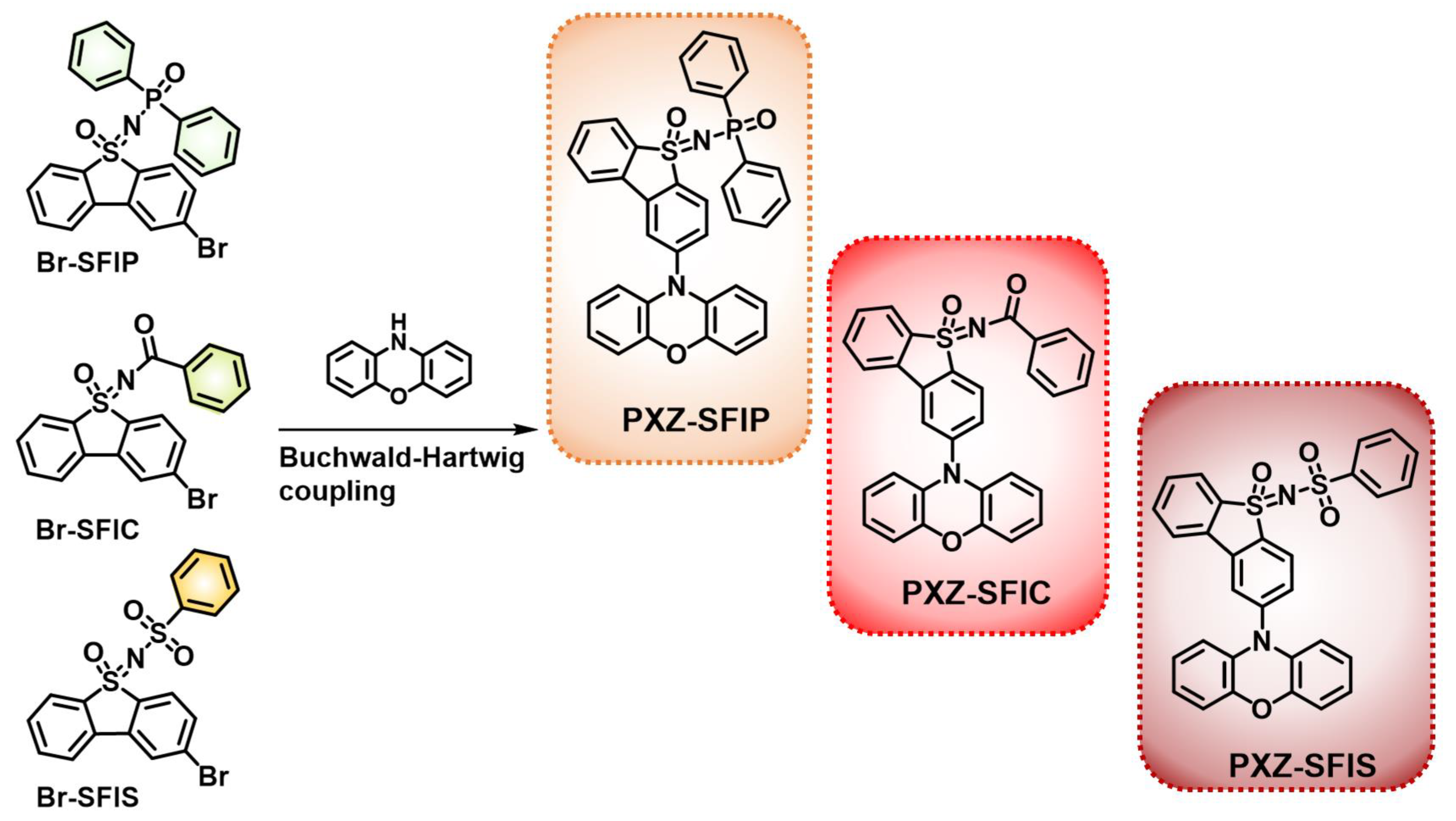
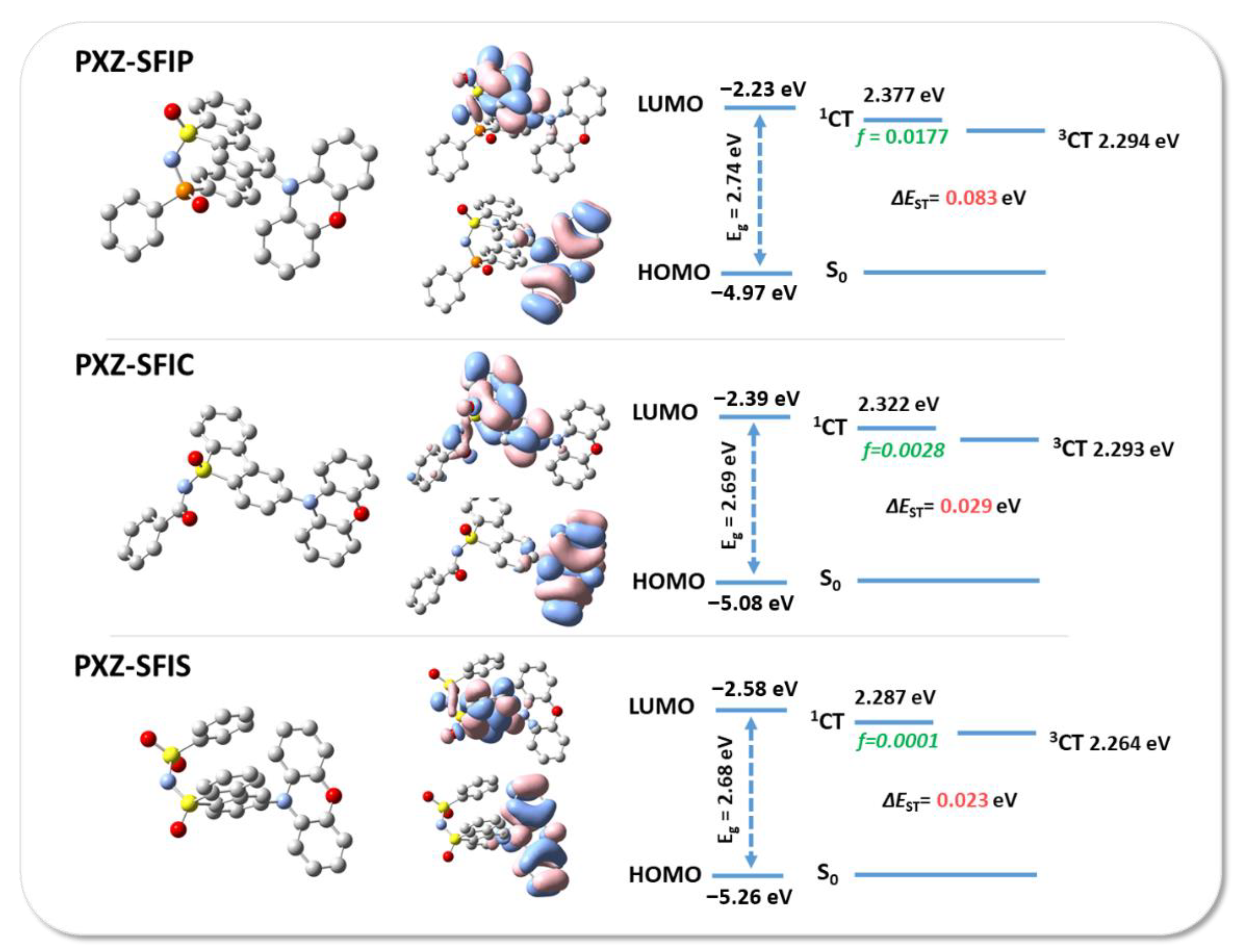
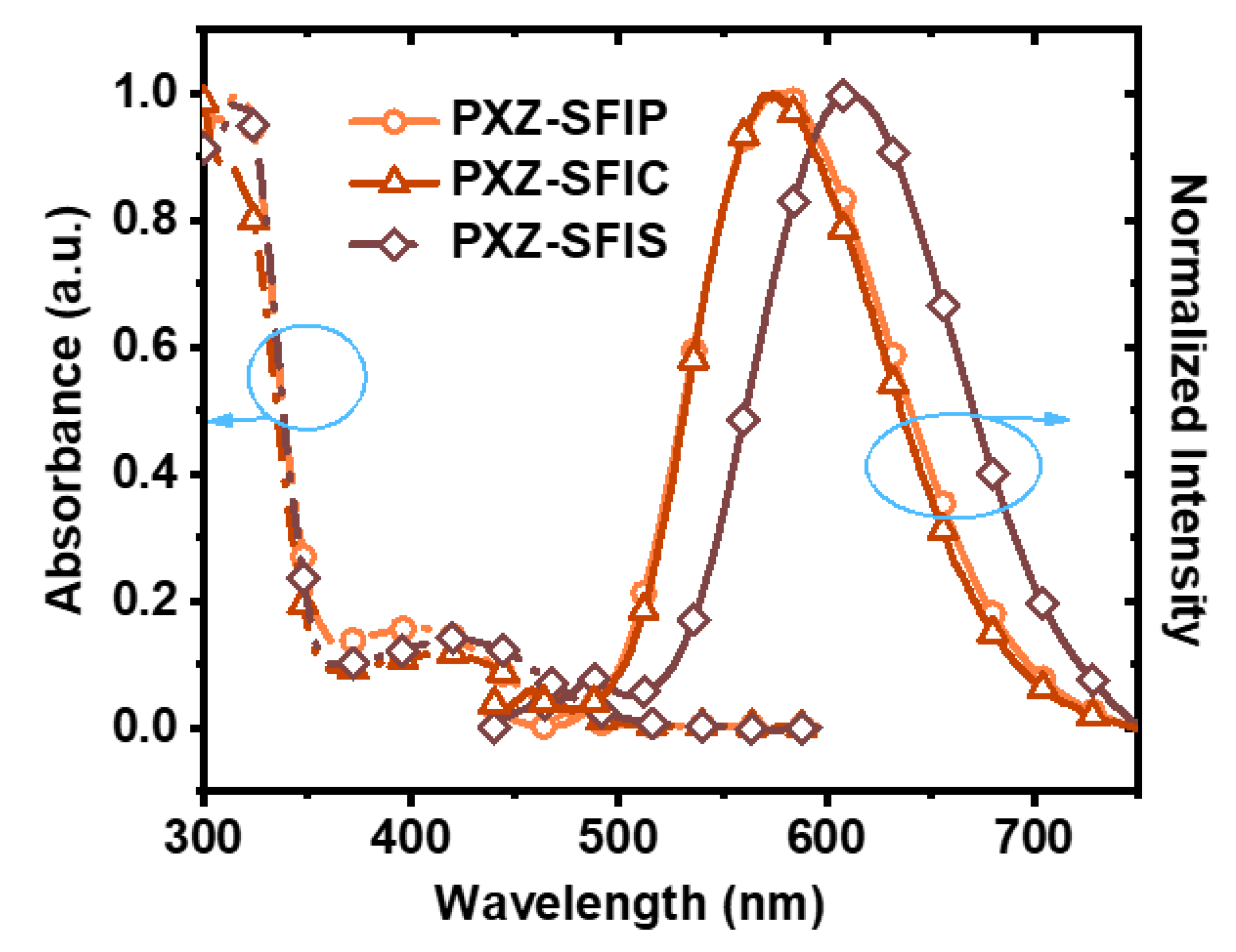
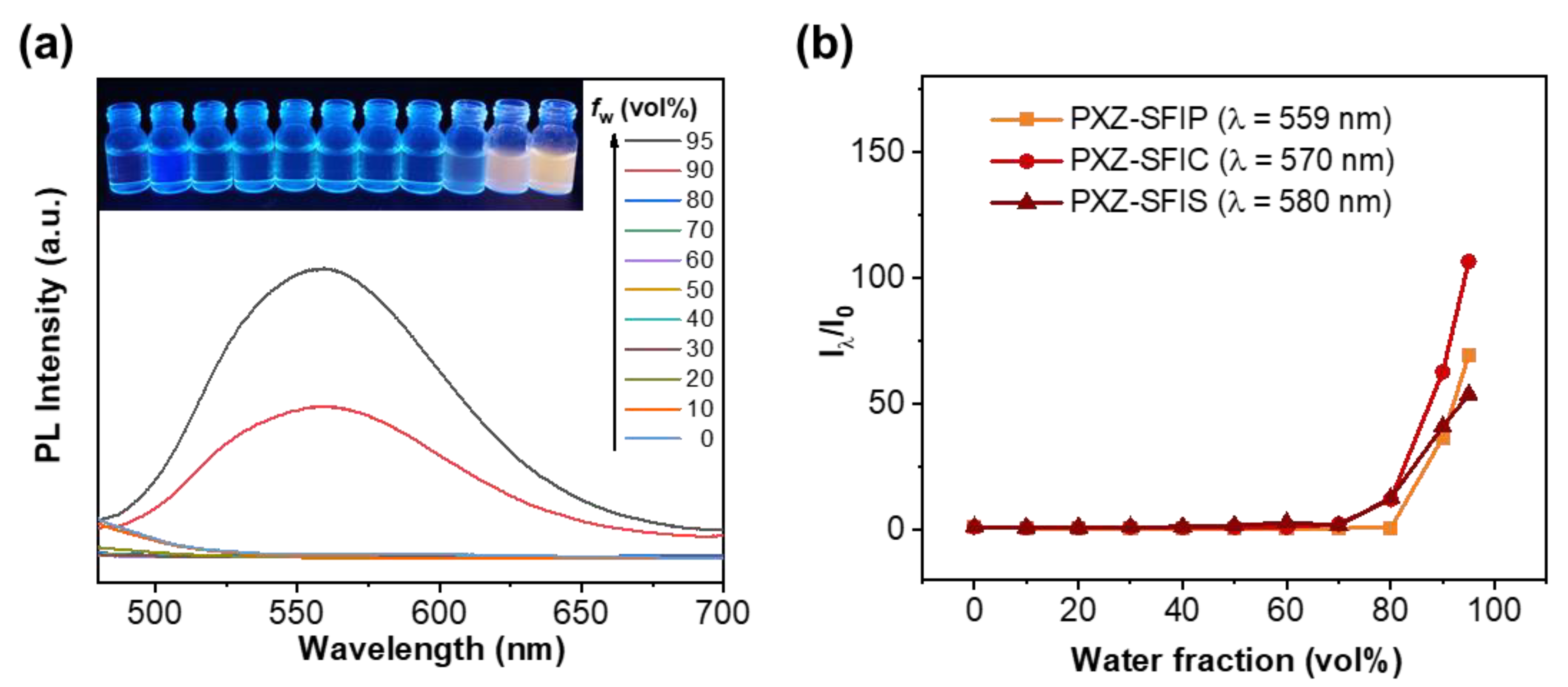
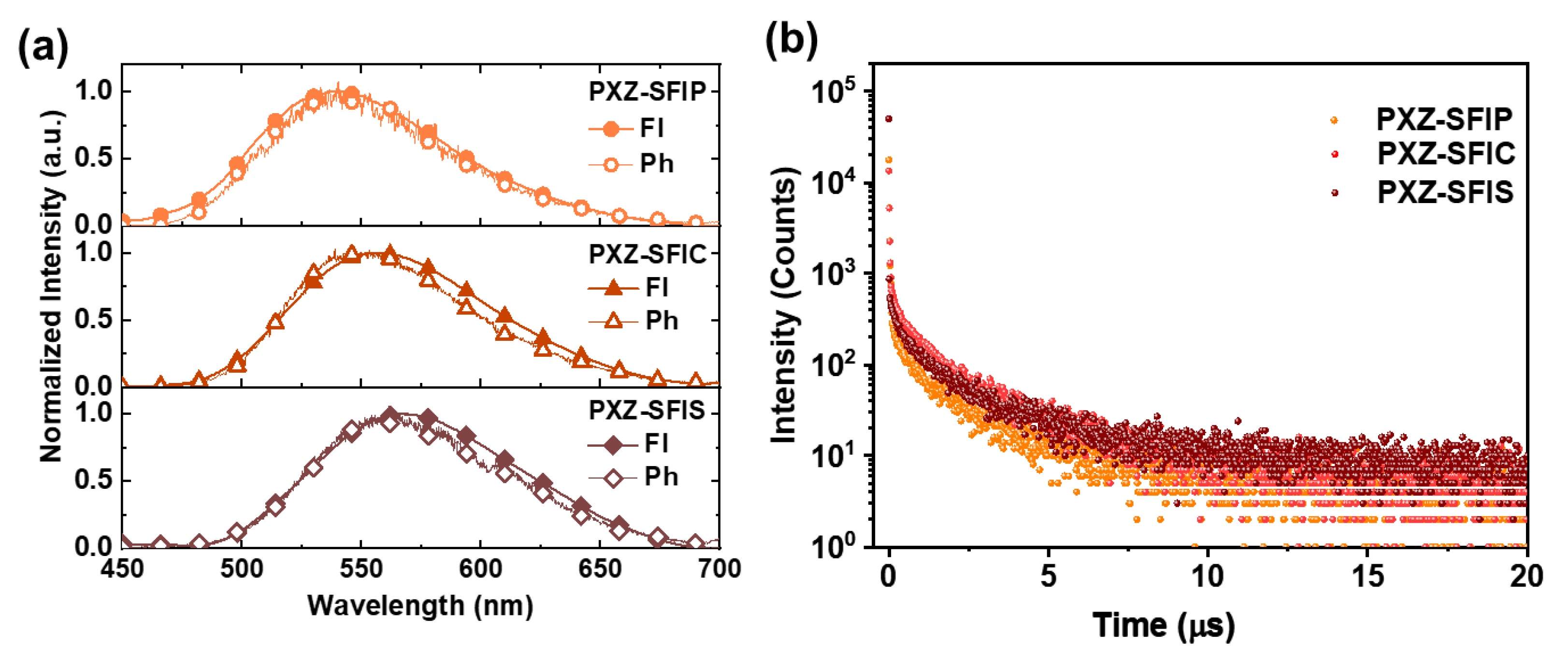
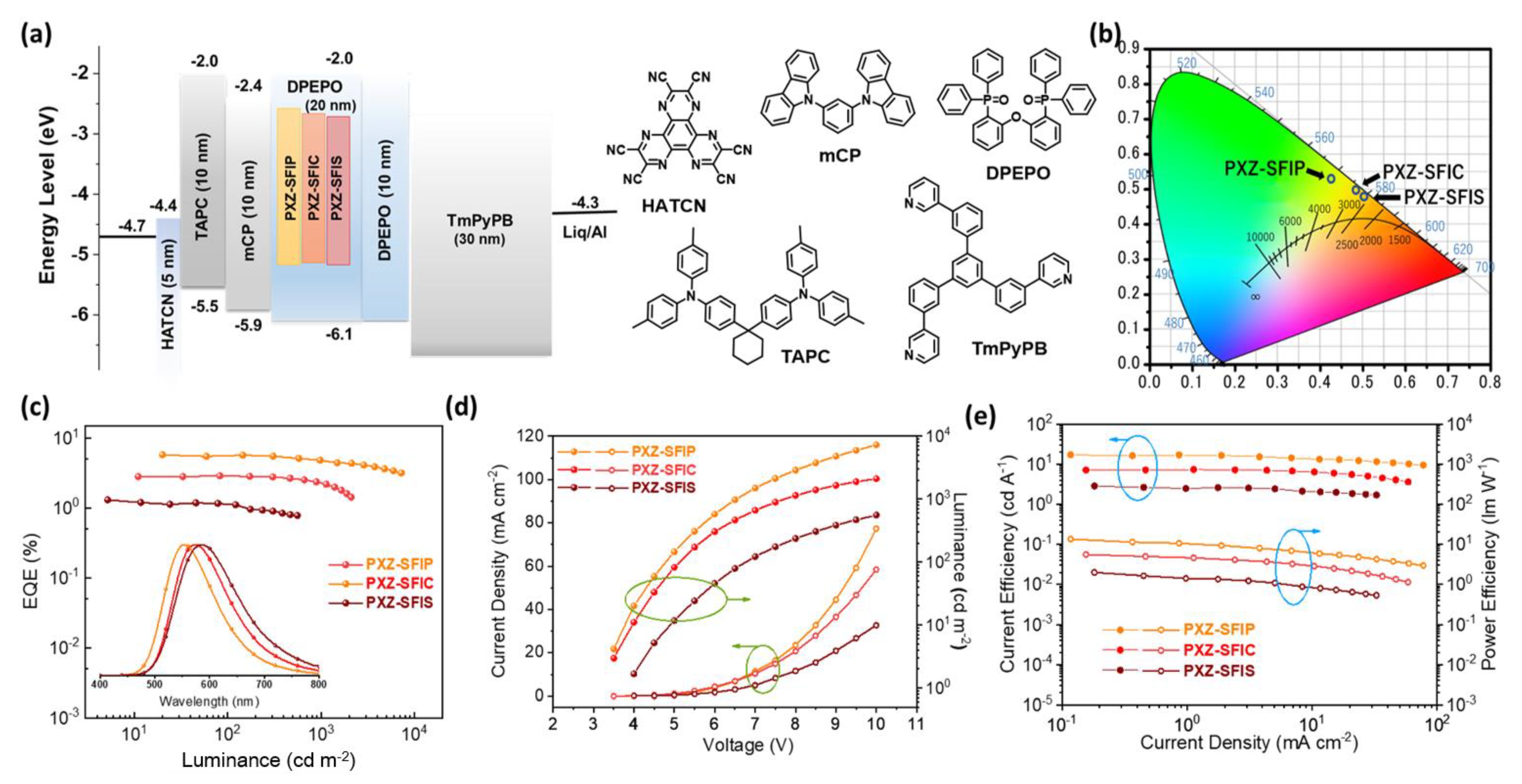
| Entry | LUMO | HOMO | Eg | S1 | T1 | ΔEST |
|---|---|---|---|---|---|---|
| (eV) | (eV) | (eV) | (eV) | (eV) | (eV) | |
| PXZ-SFIP | −2.23 | −4.97 | 2.74 | 2.38 | 2.29 | 0.08 |
| PXZ-SFIC | −2.39 | −5.08 | 2.69 | 2.32 | 2.29 | 0.03 |
| PXZ-SFIS | −2.58 | −5.26 | 2.68 | 2.29 | 2.26 | 0.02 |
| Compound | λabs a (nm) | λem a (nm) | λem b (nm) | Eg c (eV) | HOMO d/LUMO e (eV) | S1 f/T1 g (eV) | ΔEST (eV) |
|---|---|---|---|---|---|---|---|
| PXZ-SFIP | 317/403 | 576 | 539 | 2.60 | −5.19/−2.59 | 2.61/2.59 | 0.02 |
| PXZ-SFIC | 313/413 | 574 | 556 | 2.54 | −5.18/−2.64 | 2.54/2.52 | 0.02 |
| PXZ-SFIS | 318/421 | 611 | 568 | 2.49 | −5.19/−2.70 | 2.51/2.48 | 0.03 |
| Compound | ΦPL | τPF | τDF | kr,S | knr,S | kISC | kRISC |
|---|---|---|---|---|---|---|---|
| (%) | (ns) | (μs) | (×106 s−1) | (×106 s−1) | (×107 s−1) | (×106 s−1) | |
| PXZ-SFIP | 52.0 | 30.5 | 1.2 | 6.1 | 5.6 | 2.1 | 2.4 |
| PXZ-SFIC | 41.0 | 28.7 | 1.3 | 5.4 | 7.8 | 2.2 | 2.1 |
| PXZ-SFIS | 21.0 | 29.9 | 1.2 | 2.7 | 10.2 | 2.1 | 2.2 |
| Emitter | Von a (V) | CEmax b (cd A−1) | PEmax b (lm W−1) | EQE b (%) | ELpeak (nm) | CIE c (x,y) |
|---|---|---|---|---|---|---|
| PXZ-SFIP | 3.5 | 17.06 | 13.40 | 5.75/5.58/4.79 | 553 | (0.42, 0.54) |
| PXZ-SFIC | 3.5 | 8.01 | 7.19 | 3.17/2.89/2.27 | 572 | (0.48, 0.50) |
| PXZ-SFIS | 4.0 | 2.85 | 1.99 | 1.30/1.14/- | 584 | (0.50, 0.48) |
Publisher’s Note: MDPI stays neutral with regard to jurisdictional claims in published maps and institutional affiliations. |
© 2021 by the authors. Licensee MDPI, Basel, Switzerland. This article is an open access article distributed under the terms and conditions of the Creative Commons Attribution (CC BY) license (https://creativecommons.org/licenses/by/4.0/).
Share and Cite
Yang, Y.; Xiao, R.; Cao, X.; Chen, Z.; Lv, X.; Zhang, Y.; Gong, S.; Zou, Y.; Yang, C. Phenoxazine-Dibenzothiophene Sulfoximine Emitters Featuring Both Thermally Activated Delayed Fluorescence and Aggregation Induced Emission. Molecules 2021, 26, 5243. https://doi.org/10.3390/molecules26175243
Yang Y, Xiao R, Cao X, Chen Z, Lv X, Zhang Y, Gong S, Zou Y, Yang C. Phenoxazine-Dibenzothiophene Sulfoximine Emitters Featuring Both Thermally Activated Delayed Fluorescence and Aggregation Induced Emission. Molecules. 2021; 26(17):5243. https://doi.org/10.3390/molecules26175243
Chicago/Turabian StyleYang, Yiyu, Ran Xiao, Xiaosong Cao, Zhanxiang Chen, Xialei Lv, Youming Zhang, Shaolong Gong, Yang Zou, and Chuluo Yang. 2021. "Phenoxazine-Dibenzothiophene Sulfoximine Emitters Featuring Both Thermally Activated Delayed Fluorescence and Aggregation Induced Emission" Molecules 26, no. 17: 5243. https://doi.org/10.3390/molecules26175243
APA StyleYang, Y., Xiao, R., Cao, X., Chen, Z., Lv, X., Zhang, Y., Gong, S., Zou, Y., & Yang, C. (2021). Phenoxazine-Dibenzothiophene Sulfoximine Emitters Featuring Both Thermally Activated Delayed Fluorescence and Aggregation Induced Emission. Molecules, 26(17), 5243. https://doi.org/10.3390/molecules26175243








